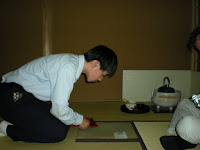




Alas, all good things must come to an end. Day 17 marked our last day in the Land of the Rising Sun. It was time to bid Japan goodbye or sayonara.
With 160 teachers flying back to various parts of America, there was a carefully crafted system of bag checks, hotel check outs, bus departures, and flight departures. I was slated for the last bus and flight departure...what's with me going last on this trip (not like it was a bad thing...just a funny coincidence)? So, I had some time to do some final sightseeing, but I couldn't go too far with all the prerequisite checks in between the day.
So I took a walk around the neighborhood of Akasaka surrounding our hotel at the Grand Prince. Just across the street was a 300 year old garden complete with waterfalls, ponds, and tea ceremony houses. Despite being a busy metropolis, Tokyo is abundant in various gardens, temples, and shrines. It's a wonderful balance of zen and industry. Without a doubt, she is the cleanest city I've seen with such a storied history. Remnants of old castles are still ever present amidst the skyscrapers and bright lights.
After returning to the hotel to do room checkout, Dr. Joe and I went exploring and searching for a Roman Catholic church that was supposed to be about 15-20 minutes away on foot. With map in hand, we found St. Ignatius Cathedral in the midst of the university setting. The architecture of the newly rebuilt building was fabulous. Sporting numerous floor to ceiling stained-glass windows and an intricate ceiling design, she was just gorgeous. The interesting part was that upon trying to enter the building, we ran into an older Italian gentleman in a suit and we started to converse. We then found out that he was the main priest at the church. He had lived in Japan for over 40 years since leaving Italy. He then proceeded to give us these beautiful and thick coffee table picture books about the church. Wow....what a blessing and a wonderful way to end my trip.
We then went back to the hotel and waited for our turn to depart. As a final note of Japan, the effort put into their generosity, hospitality, and service is unparalleled. The Japanese go out of their way to help others especially foreigners. The mix of personal honor and genuine generosity drives them to do things like walk a mile to make sure a stranger gets to their destination safely. A number of our teachers experienced complete Japanese strangers ride with them to their stop on the subway so that they got off on the right stop. At our hotel, I immediately noticed how keen the staff were to always scan the room to spot and anticipate whoever may need help. They don't just wait around to be asked. They actively try to predict how they can help you out. To top it all off, as each of our buses left, all available staff would stand outside and wave our buses goodbye.
Well, thank you for taking this trip virtually with me. It has definitely been a once in a lifetime type of opportunity. If you ever have the chance, you must visit Japan. She is a place unlike any other. There is so much we all can learn from each other.















































